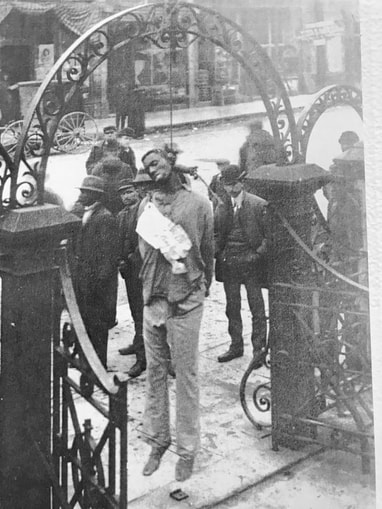 George Carter and the crowd he attracted after his hanging in February 1901. George Carter and the crowd he attracted after his hanging in February 1901. I have been haunted by the case of Ralph Jarl, the Black 16-year-old in Missouri who was shot by Andrew Lester after ringing the elderly white man’s doorbell. Jarl’s mother had asked him to pick up his two younger brothers at a nearby home, but Jarl had mistakenly approached a home on the wrong street. Everything about this situation is shocking. Lester’s behavior is reprehensible and inexcusable, no matter how broadly you interpret Missouri’s Stand Your Ground law. Jarl did nothing more threatening than ring the man’s doorbell. In my youth, someone like Lester might have yelled, “Scram, you punk!” (Well, he might have used a different epithet.) Lester also could have opted to ignore the doorbell and simply not answer the door. But Lester made the choice to shoot the teenager—twice—without exchanging any words. In the criminal complaint, Lester stated that he was “‘scared to death’ due to the male’s size.” This is the detail that caught my attention. Jarl’s family has reported that the youngster is 5’8” and weighs 140 pounds. Lester claimed Jarl was 6 feet tall. There is a considerable discrepancy here between reality and Lester’s perception. I have seen this before. In Tessa Bishop Hoggard’s book In the Courthouse’s Shadow: The Lynching of George Carter, Hoggard relays the story of my great-grandmother’s alleged assault by a Black man while crossing a covered bridge in Paris, Ky., in December 1900. The initial report in the Kentuckian-Citizen newspaper described the incident as an attempted purse snatching. In my great-grandmother’s words, her attacker “had brown skin, weight about 200 pounds, fairly well dressed….” Two months later, a suspect was pulled from his jail cell by a group of local men and lynched in front of the county courthouse. The victim of this extrajudicial justice, George Carter, had never been charged with my great-grandmother’s assault. He was being held in the jail for another offense. But rumors had led to suspicions that he was the guilty man, and the crime against my great-grandmother had also morphed in the prurient imaginations of concerned citizens. But, as you can see from the photo, George Carter clearly was not 200 pounds. In their rush to defend my great-grandmother’s honor, did the mob hang a man who had nothing to do with the incident on the bridge? Or was the description my great-grandmother gave the newspaper at the time of the attack yet another example of white victims reporting Black perpetrators as much larger and more physically threatening than they actually are? In her book, Hoggard also relays the story of another mob lynching in Paris in 1889, where the victim had again been described by the woman he allegedly attacked as “a large, burly Negro, weighing over 200 pounds.” We have no photograph of Jim Kelly to confirm his physical size, but the common language feels suspicious, like a trope that was cemented in the minds of a fearful white population. According to the Washington Post: “In multiple studies, people who were asked to judge the size of Black people tended to see Black men as bigger and stronger than they actually were, and gave Black children the attributes of adults. The result is that they are seen as more dangerous....In some studies, [Kurt Hugenberg, a professor in psychological and brain sciences at Indiana University] showed participants images of Black men and White men who are about the same height and weight. Participants often thought the Black men appeared larger...” Yes, Virginia, there is systemic racism. It permeates so many aspects of our lives and our interactions that even those of us who try valiantly to reject racist tropes inevitably fall under their sway. Racism is pernicious, it’s prevalent, and it’s dangerous. If we refuse to recognize that, we can’t even begin to chip away at the corrosion it has caused. And our fellow citizens will continue to pay the price.
4 Comments
Vincent Fallis
4/26/2023 07:34:08 am
That's exactly why it is very interesting that the two Tennessee legislators who were summarily drummed out of the House of Representatives were both young, educated, well spoken and not physically imposing men. They had to be dealt with as equals who were correctly calling for the government to address the despicable proliferation of military style weapons into the hands of citizens who have no need for them and are not subject to reasonable vetting to own them. An encouraging sign of all this was the awakening of the students to demand accountability on the part of lawmakers. The Tennessee Governor has called a special legislative session to address the issue. This would have been unimaginable prior to the tragedy at the elementary school and certainly would not have occurred without the courage and determination of these two black legislators who refused to take no for an answer in a hostile environment. Hope springs eternal.
Reply
Barbara R Fallis
4/26/2023 06:04:48 pm
Most seem to think that the Civil Rights Movement of the 1960s was mainly to elevate Blacks to their rightful citizenship. I add that it elevated us, White people, to a better awareness of our world and what we are capable of - to be part of the vast cultural attributes and failings of all people. We woke up.
Reply
Tessa Bishop Hoggard
4/29/2023 06:39:51 pm
Amen, Sallie! Research for my book revealed that the practice of portraying black men as big brutes has deep roots in our history. Its purpose was to dehumanize people of color, to stoke fear in a people who felt superior, and to justify brutal acts of violence. Acts of crime should never remain buried under the dark cloud of shame and ignorance. Instead, use it as a learning tool for this generation and those to come lest the cycle is never broken. Thanks for your heartfelt insight!
Reply
Sallie Showalter
4/29/2023 08:11:25 pm
And thank you, Tessa, for educating us through your poignant book.
Reply
Your comment will be posted after it is approved.
Leave a Reply. |
Details
Archives
June 2023
Categories
All
|


 RSS Feed
RSS Feed